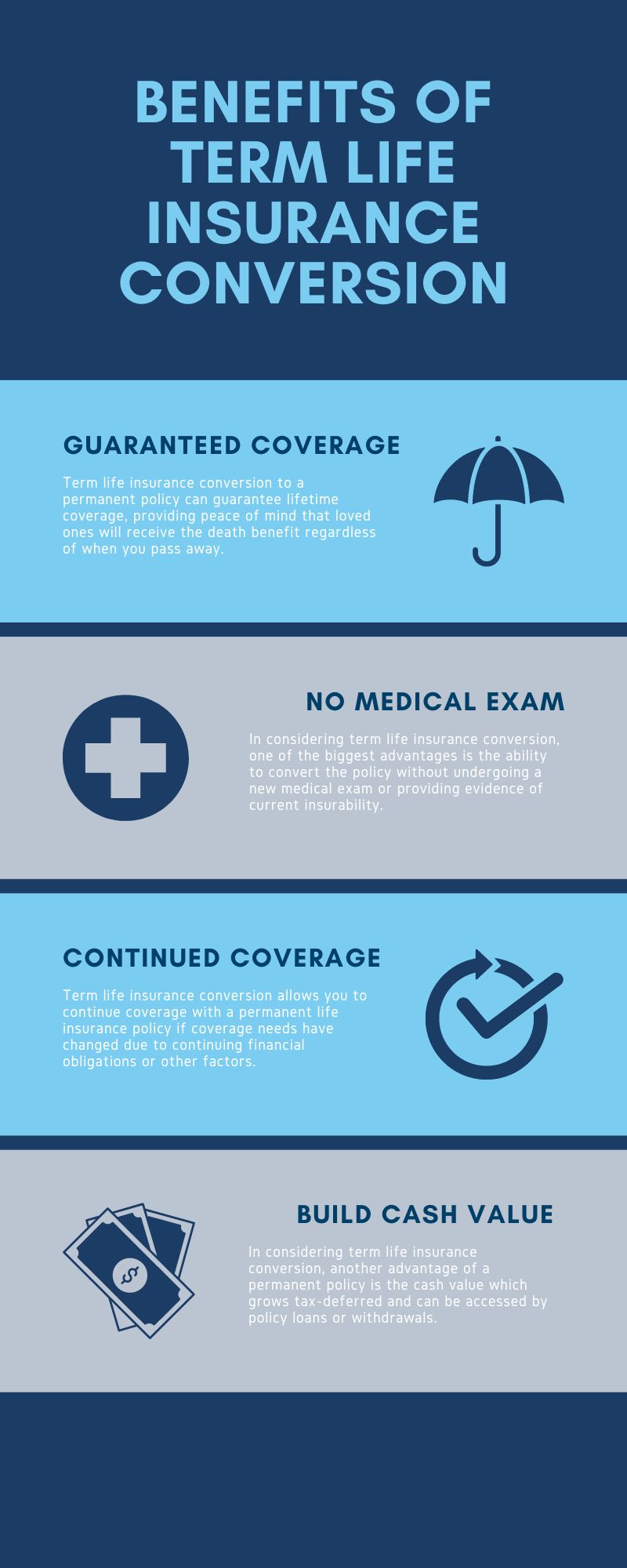Term Life Insurance Conversion Policy Options

Term life insurance is an excellent choice for individuals looking for affordable and straightforward coverage for a specific period. However, what happens when coverage needs change, or the term comes to an end? That's where term life insurance conversion comes into play. By converting your policy, you can extend your coverage without the hassle of reapplying or going through a medical exam.
In this article, we will delve into the benefits and intricacies of term life insurance conversion, helping you navigate this process with confidence. Whether you're a current policyholder or someone considering term life insurance for the first time, we will help in sharing the knowledge needed to maximize your coverage and make informed decisions.
Understanding Term Life Insurance
Term life insurance is a type of life insurance policy that provides coverage for a specific period, typically ranging from 10 to 30 years. It offers a death benefit to the beneficiaries if the insured passes away during the term. Unlike permanent life insurance, which provides coverage for the insured’s entire life, term life insurance is temporary and designed to meet specific financial needs, such as providing income replacement, paying off debts, or funding education expenses. Term life insurance policies are generally more affordable compared to permanent life insurance policies, making them an attractive option for individuals looking for cost-effective coverage.
Term life insurance policies come with a predetermined term length, which can vary depending on the individual’s needs and preferences. Common term lengths include 10, 15, 20, or 30 years. During the term, the insured pays regular premiums to maintain the coverage. If the insured passes away within the term, the death benefit is paid out to the beneficiaries. However, if the insured outlives the term, the policy expires, and no death benefit is paid out. This is where term life insurance conversion comes into play, offering a way to extend coverage beyond the initial term without the need for additional underwriting.
What is term insurance conversion?
Term life insurance conversion is a feature that allows policyholders to convert their term life insurance policy into a permanent life insurance policy without undergoing a new medical exam or providing evidence of insurability. Permanent life insurance, such as whole life or universal life insurance, provides coverage for the insured’s entire life, as long as the premiums are paid. This means that converting a term life insurance policy to a permanent policy offers lifelong coverage and the potential to accumulate cash value over time.
The conversion feature is typically included in the terms of the term life insurance policy and allows policyholders to convert their coverage within a specified conversion period. The conversion period is usually limited to a certain age or number of years from the policy’s inception. It’s important to note that term life insurance conversion is not available for all term life insurance policies, so it’s crucial to review the policy terms and conditions to determine if conversion is an option.
Term Life Conversion Benefits
Term life insurance conversion offers several benefits for policyholders, making it a valuable feature to consider. Here are some of the key advantages:
Guaranteed coverage: Converting your term life insurance policy to a permanent policy guarantees coverage for the rest of your life, as long as you continue to pay the premiums. This provides peace of mind knowing that your loved ones will receive a death benefit regardless of when you pass away.
No medical exam: One of the biggest advantages of term life insurance conversion is the ability to convert without undergoing a new medical exam or providing evidence of insurability. This is especially beneficial if your health has deteriorated since you first obtained the term life insurance policy, as it allows you to secure permanent coverage without the risk of being denied or charged higher premiums due to your current health condition.
Continued Coverage: Converting a term life insurance policy allows you to continue coverage with a new permanent life insurance policy. This can be important if your coverage needs have changed since initially purchasing term coverage. The need for continued life insurance coverage can involve a variety of circumstances, such as continued financial obligations, special needs family members, the desire to leave an inheritance, or others factors.
Cash value accumulation: Permanent life insurance policies, including those obtained through term life insurance conversion, have the potential to accumulate cash value over time. Cash value is a portion of the premium payments that grows tax-deferred and can be accessed during the insured’s lifetime through policy loans or withdrawals. This can provide a source of funds for various financial needs, such as supplementing retirement income or covering unexpected expenses.
Eligibility for Term Life Conversion
Not all term life insurance policies offer the option to convert, and there may be specific eligibility requirements that need to be met. The conversion eligibility criteria can vary between insurance companies and policies, so it’s essential to review your policy documents or consult with your insurance agent to understand the specific requirements. However, here are some common eligibility factors to consider:
Conversion period: Term life insurance conversion is typically available within a specific conversion period, which is defined in the policy terms. This period can range from a few years to the end of the term or a specific age, such as 65 or 70. It’s important to convert before the conversion period expires, as you may lose the opportunity to convert once this period has passed.
Insurability: While term life insurance conversion does not require a new medical exam or evidence of insurability, it’s important to note that the eligibility for conversion is based on the original underwriting of the term life insurance policy. If you were initially approved for the term life insurance policy, you should generally be eligible for conversion, regardless of any changes in your health. However, if you were originally rated or declined during the underwriting process, conversion may not be available.
Policy type: The availability of term life insurance conversion may vary depending on the type of policy you have. Some policies may offer conversion options to multiple types of permanent life insurance, such as whole life or universal life, while others may have limitations or restrictions. It’s crucial to review your policy documents or consult with your insurance agent to understand the conversion options available to you.
How Term Life Conversion Works
Term life insurance conversion is a straightforward process that allows policyholders to convert their term policy into a permanent policy. Here’s a step-by-step overview of how term life insurance conversion typically works:
- Review your policy: Start by reviewing your term life insurance policy documents to understand the conversion options available to you. Pay close attention to the conversion period, conversion types, and any limitations or restrictions.
- Contact insurance company: If you’re interested in converting your term life insurance policy, reach out to your insurance company or agent to initiate the conversion process. They will guide you through the necessary steps and provide you with the required documentation.
- Select the conversion type: Depending on your policy and the options available, you may have the choice to convert to different types of permanent life insurance, such as whole life or universal life. Consider your financial needs and goals to determine the most suitable conversion type for you.
- Complete conversion application: Once you’ve selected the conversion type, you will need to complete a conversion application. This application typically requires basic information about yourself, the policy details, and the desired conversion type. Your insurance company will provide you with the necessary forms and instructions.
- Pay the premium: To convert your term life insurance policy, you will need to pay the premium associated with the permanent policy. The premium amount will depend on various factors, including your age, health rating, desired coverage amount, and the conversion type selected. Your insurance company will provide you with the premium details and payment options.
- Review new policy: After completing the conversion process and paying the premium, you will receive a new permanent life insurance policy. Take the time to review the policy documents and ensure that all the details, including the coverage amount, premium, and beneficiaries, are accurate.
- Continue paying premiums: Once your term life insurance policy is converted to a permanent policy, you will need to continue paying the premiums to maintain the coverage. Make sure to understand the premium payment schedule and options available to you.
Factors to Consider in Term Conversion
Term life insurance conversion can be a beneficial option for many policyholders, but it’s essential to consider several factors before making the decision to convert. Here are some key considerations:
Financial affordability: Converting a term life insurance policy to a permanent policy typically results in higher premiums. Before converting, assess your financial situation and ensure that you can comfortably afford the increased premium payments. Consider your current income, expenses, and long-term financial goals to determine if the conversion aligns with your budget.
Coverage needs: Evaluate your current coverage needs and how they may change in the future. If your financial obligations, such as mortgage payments or education expenses, are temporary and will be fully paid off within the remaining term of your term life insurance policy, conversion may not be necessary. On the other hand, if you have ongoing financial responsibilities or want to leave a legacy for your loved ones, converting to a permanent policy can provide lifelong coverage.
Health condition: While term life insurance conversion does not require a new medical exam, it’s important to consider your health condition in converting. If your health has significantly deteriorated since you first obtained the term life insurance policy, conversion might be an effective way to continue coverage since you may not be able to qualify for a new policy in the future. Assess your health and consult with your insurance agent to understand how your current health may impact future insurability.
Cash value accumulation: If cash value accumulation is a priority for you, converting to a permanent policy can provide the opportunity to build cash value over time. However, it’s crucial to understand the cash value growth potential and the associated costs, such as policy fees and charges. Evaluate the projected cash value growth and determine if it aligns with your financial goals.
Alternative options: Before converting, explore alternative options to meet your coverage needs. For example, you may consider purchasing a new term life insurance policy if you require temporary coverage for a specific period. Comparing the costs and benefits of different options can help you make an informed decision.
Misconceptions About Term Conversion
Term life insurance conversion can sometimes be surrounded by misconceptions that may prevent individuals from considering this valuable option. Let’s address some of the common misconceptions:
- Conversion is too expensive: While converting a term life insurance policy to a permanent policy typically results in higher premiums, it’s important to evaluate the long-term benefits and financial implications. Consider the guaranteed coverage, potential cash value accumulation, and the ability to secure coverage without a medical exam. It can be helpful to assess your financial situation and determine if the conversion aligns with your goals and objectives.
- Conversion is for the unhealthy: Term life insurance conversion is often available to policyholders regardless of their current health condition. It can allow individuals to secure permanent coverage without the risk of being denied or charged higher premiums based on their current health.
- Conversion is too complicated: While the conversion process involves several steps, it is generally straightforward and can be completed with the assistance of your insurance company or agent. The conversion application typically requires basic information, and the payment of the premium can be done using various convenient options.
Alternatives to Term Insurance Conversion
Term life insurance conversion may not be the best option for everyone. Depending on your specific needs and circumstances, alternative options may be more suitable. Here are some alternatives to consider:
Purchasing a new life insurance policy: If your coverage needs are temporary and limited to a specific period, purchasing a new term life insurance policy may be a more cost-effective option. This allows you to tailor the coverage amount and term length to your current financial situation and obligations.
Supplementing with additional coverage: Instead of converting your entire term life insurance policy, you may consider supplementing it with additional coverage. This can be achieved by purchasing a new permanent life insurance policy alongside your existing term policy. This approach provides the flexibility of both temporary and lifelong coverage.
Exploring other permanent life options: If you’re interested in permanent coverage but don’t want to convert your term policy, explore other permanent life insurance options available in the marketplace.
Conclusion
In conclusion, a term life insurance conversion is a policy feature that allows a policyholder to convert their term life insurance policy into a permanent life insurance policy without undergoing a new medical exam or providing evidence of insurability. This can be a great option if you have a need for continued coverage and are interested in the potential to accumulate cash value over time. It is important to work with a qualified insurance professional to determine coverage objectives and available options.
Are you considering a term life insurance conversion? Choicelifequote.com can assist in choosing the right type of policy, an appropriate amount of coverage, and the best insurance company for your situation. Get the quality coverage you need at affordable rates. Give us a call at (800) 770-8229 or request an instant quote today!
Disclaimer: Information is intended to be educational in nature and should not be considered financial, tax, or legal advice. Please consult a qualified professional for advice regarding your individual situation.
The Staff Writers at ChoiceLifeQuote.com are insurance and financial services professionals with significant industry experience. The team’s experience and expertise help to provide consumers with a variety of educational content related to life insurance and annuities.



